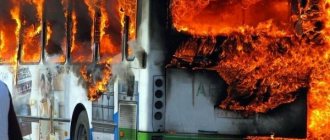Basic actions to take when a fire starts
Here is a list of steps to follow:
- As soon as the source of the fire is discovered, you must immediately dial the fire department 101 or dispatch service 112 and provide accurate information about the location of the fire, the characteristics of the object, and the cause of the fire (if possible). It is mandatory to meet fire departments near the entrance to the building. If children were the first to notice a fire, then adults should be told about it immediately.
- If the fire is at the initial stage, then try to extinguish it on your own, using thick fabric blankets, bedspreads, you can pour water on the fire, cover it with sand or earth.
- If an electrical fire catches fire, never use water to extinguish it. Not only will it not put out the fire, but it can also harm the life and health of nearby people.
- If the fire flared up with particular force and you are not able to cope with it yourself, try to quickly leave the burning room and help others do so.
- It is strictly contraindicated to hide in secluded places when a fire starts, especially since smoke can begin at any moment, which negatively affects the respiratory tract.
It is always worth remembering that it is easier to prevent a fire than to fight the fire later. Therefore, fire safety rules must be observed always and everywhere.
Procedure in case of fire
A fire always occurs suddenly and takes people by surprise. Few people can pull themselves together in this situation, think sensibly and organize people to take the right actions to put out the fire. As a rule, panic begins, which can lead to negative consequences. In order to avoid disastrous results, you need to know how to behave when a fire starts.
Basic actions to take when a fire starts
Here is a list of steps to follow:
- As soon as the source of the fire is discovered, you must immediately dial the fire department 101 or dispatch service 112 and provide accurate information about the location of the fire, the characteristics of the object, and the cause of the fire (if possible). It is mandatory to meet fire departments near the entrance to the building. If children were the first to notice a fire, then adults should be told about it immediately.
- If the fire is at the initial stage, then try to extinguish it on your own, using thick fabric blankets, bedspreads, you can pour water on the fire, cover it with sand or earth.
- If an electrical fire catches fire, never use water to extinguish it. Not only will it not put out the fire, but it can also harm the life and health of nearby people.
- If the fire flared up with particular force and you are not able to cope with it yourself, try to quickly leave the burning room and help others do so.
- It is strictly contraindicated to hide in secluded places when a fire starts, especially since smoke can begin at any moment, which negatively affects the respiratory tract.
It is always worth remembering that it is easier to prevent a fire than to fight the fire later. Therefore, fire safety rules must be observed always and everywhere.
How to call the fire department correctly
Everyone should know these actions in order to prevent the disastrous consequences associated with a fire. First of all, you need to call the fire department in any way convenient for you: this can be a landline telephone or a mobile phone.
Moreover, information about the fire must be comprehensive and relevant to reality, so that even before the arrival of a specialized fire brigade, it can assess the situation, determine how to fight the fire, as well as the use of specific fire extinguishing agents. In addition to this necessary information, the specific address of the fire, the characteristics of the fire, whether there is a threat to human life and what their approximate number is, the best and fastest way to approach the burning building and, without fail, give your name and means of communication.
How to recognize a fire that has started
In a residential building, as a rule, a fire starts from an open small combustion source or from a gas explosion. Therefore, at first a slight acrid odor is felt, and then signs of smoke appear. If the electrical wiring begins to heat up, a characteristic smell of rubber is felt, and then the insulation begins to burn, igniting all objects located nearby.
How to call the fire department correctly
Everyone should know these actions in order to prevent the disastrous consequences associated with a fire. First of all, you need to call the fire department in any way convenient for you: this can be a landline telephone or a mobile phone.
Moreover, information about the fire must be comprehensive and relevant to reality, so that even before the arrival of a specialized fire brigade, it can assess the situation, determine how to fight the fire, as well as the use of specific fire extinguishing agents. In addition to this necessary information, the specific address of the fire, the characteristics of the fire, whether there is a threat to human life and what their approximate number is, the best and fastest way to approach the burning building and, without fail, give your name and means of communication.
How to recognize a fire that has started
In a residential building, as a rule, a fire starts from an open small combustion source or from a gas explosion. Therefore, at first a slight acrid odor is felt, and then signs of smoke appear. If the electrical wiring begins to heat up, a characteristic smell of rubber is felt, and then the insulation begins to burn, igniting all objects located nearby.
Immediately, interruptions in the light begin, the lights flash, which also indicates an impending threat. If the premises have good ventilation (doors and windows are open), then people in the room first hear the crackling sound of burning wood, and only then the smell of burning. If you know all the signs of a fire, you can deal with it quickly and effectively.
As soon as people feel the first signs of a fire, they must immediately report it to the fire department. It is worth remembering that the speed of arrival of fire crews plays a big role in localizing the source of fire and minimizing negative consequences. It is necessary to call the fire brigade even when there is very little smoke in the room, and the source of its appearance cannot be identified.
The fire will quickly spread in residential premises thanks to ventilation ducts, doors, and window openings through which there is an influx of clean air, which gives rise to increased burning of the flame. Therefore, when a fire appears, windows and doors should be closed tightly so that the fire does not spread to neighboring areas.
If the fire flares up very quickly, and the primary fire extinguishing means are not enough to completely eliminate the source of the fire, you need to urgently evacuate people, and also try to turn off the gas and de-energize the room. Much attention should be paid to children who may be afraid of fire and hide in secluded places. They need to be saved first.
First actions in case of fire
The earlier a fire is detected, the greater the likelihood of extinguishing it without allowing it to spread. Therefore, the presence of the following signs should alert you:
- The appearance of a characteristic odor. A fire often starts with smoldering wiring, so the smell of burning plastic can be a dangerous harbinger.
- Turn off or reduce the brightness of lighting fixtures.
- Sensation of smoke in the eyes, appearance of visible thick smoke.
- Sounds of crackling fire (sometimes characteristic odors do not spread throughout the house due to good ventilation, then the danger can only be determined by sound).
If one of these signs is detected, turn off the power to the apartment and find the source of ignition. Then proceed in accordance with the procedure for action in case of fire.
Actions in case of fire in a residential area
In the event of a fire in a residential building, you may encounter certain difficulties, such as night time, problems with evacuation. You can quickly and effectively solve any problem if you prepare for it in advance:
- preview the evacuation routes and make sure that they are not cluttered with foreign objects, are in good condition and can be used to freely leave the premises;
- if it is necessary to evacuate a person with physical disabilities, then it is advisable that they live on the first floors or be in the room closest to the exit;
- if it is difficult for a person to move, then there should be a telephone or other means of communication in close proximity to the bed.
In order not to encounter a fire at night, it is necessary to take a number of actions in the evening to avoid a fire:
- check whether all electrical appliances that should not be constantly turned on are disconnected from the network (irons, soldering irons, etc.);
- close the valves on all gas appliances;
- never leave cigarettes unextinguished;
- if you warmed up the premises with temporary heaters, do not forget to turn them off;
- If the house has fireplaces or stoves with open fires, it is necessary to install fences next to them.
Procedure in case of fire in a residential apartment building
If you are near a fire or notice a fire in your home, you need to take certain actions that may save the lives of you, your loved ones and your housemates. The sequence of actions will be different depending on where the fire occurred.
Procedure in case of fire in the apartment:
- First of all, you need to call the fire department.
- Evacuate frail and incapacitated citizens, children and the elderly. In this case, people must be taken outside the building; under no circumstances should they use the elevator.
- Remove the plugs (turn off the circuit breaker) and turn off the power to the apartment.
- If the fire area is small, try to localize the fire yourself using available means. You can use a container of water to extinguish.
- If a liquid (oil, solvent) is burning, extinguishing it with water can only aggravate the situation; it is recommended to use any dense materials (for example, felt).
- If you were unable to prevent the fire from spreading and your life is in danger, it is better to leave the room as soon as possible, having previously tightly closed the doors and windows.
- There is no way to exit through the front door, go to the balcony, the door must be closed tightly behind you, if there is a fire escape, go down it. Descending using improvised ropes twisted from fabrics, various hoses, and so on is not recommended; you can use such means only in case of emergency.
These are the main actions to take in case of fire, and remember, under no circumstances open windows in a room with a fire; the supply of fresh oxygen will increase the intensity of the fire.
Actions in case of a fire in the basement:
- Call the fire department.
- Report the fire to your neighbors.
- Smoke has begun to enter the apartments, open them for ventilation.
- Do not attempt to enter the basement and put out the fire yourself.
- If you find yourself in the basement at the time of the fire, bending down to the floor, slowly move towards the exit.
Actions in case of fire in the entrance:
- Call the fire department, inform your neighbors about the fire, and help evacuate children and the elderly.
- If there is a little smoke, try to identify the source of ignition and localize the fire yourself.
- If you hear requests for help from an apartment near the fire, knock down the door (this is allowed by law) and help the victims.
- If there is heavy smoke, immediately leave the entrance; if you cannot evacuate (by stairs), go out onto the balcony and wait for rescuers.
These simple actions in the event of a fire will help you not only react quickly and act competently in such an emergency, but also save the lives of yourself, your family members and neighbors!
Article sent by: Istanbul
I like (46)
Articles on the topic
0 47
Rules of behavior in the forest. Fire safety in the forest.
Published: July 11, 2017
Wildfires, ecology and safety
Rules of behavior in the forest. Fire safety in the forest.
Published: July 11, 2021 When visiting the forest, tourists should remember the rules of behavior in the forest to comply with fire safety in the forest, which will help avoid the formation of uncontrolled flames, and also reduce or eliminate harm to the natural environment...
- Fire in a car. Car fire extinguisher. Fire safety prevention
- Fire safety prevention. Fire prevention
- Emergency chemically hazardous substances. Characteristics of hazardous substances. Signs of damage to hazardous substances
Actions in case of fire in an elevator
If a fire catches people in an elevator, the following steps must be taken:
- press the “Call” button to inform the dispatcher about a fire;
- as soon as the elevator stops, quickly vacate the cabin;
- as soon as there is no one left in the elevator, its doors must be locked in the “open” position;
- urgently call firefighters to the place of fire;
- if the elevator is stuck between floors, you need to notify the dispatcher about this and do not try to open the doors yourself and get out;
- you must constantly call for help;
- do not panic, but close your nose and mouth, sit on the floor and wait for help.
General instructions on what to do in case of fire
In a critical situation, you should always remember the safety of yourself and those around you. It is important to correctly assess the risks and rush to fight the fire only when there is no threat to life. When escaping from a burning building, try to help those around you.
If the fire cannot be controlled within 3-4 minutes, you must call the fire department. The person who made the call to the Ministry of Emergency Situations must wait for the rescuers and show them the shortest route to the place of the fire, as well as make assumptions about the people remaining captive of the fire. This will help firefighters find victims and rescue them from the fire, as well as eliminate the consequences of the disaster.
Actions in case of fire in transport
You must follow this order:
- immediately inform the driver about the fire;
- As soon as the vehicle stops, calmly leave the cabin. If the doors are jammed, you can exit through the window openings, having previously broken out the glass in them;
- help helpless people leave a burning vehicle, take them to a safe place;
- if possible, start fighting the fire yourself, before the firefighters arrive;
- try to prevent the flame from spreading to adjacent areas.
Actions in case of fire: when a person catches fire
It happens that a person’s clothing catches fire, for example, in an accident or careless handling of fire. The first reaction of the victim in such cases is often incorrect. The person begins to run and rush about, which, on the contrary, contributes to the flare-up of the flame.
The correct procedure is:
- Place the burning person in a horizontal position;
- extinguish the fire with snow, earth, water, or cover the victim with a thick blanket or cloth, leaving only the head uncovered;
- If possible, remove burning clothing;
- if the described methods do not help, then roll the person on fire on the ground.
It is forbidden to press burning clothing to the victim’s body - this will cause an even greater burn on the skin.
If a person is alone during a fire, he will have to save himself. The action steps in this case are as follows:
- Remove burning clothing;
- if you can’t get rid of burning things, then fall to the ground and roll until the fire is eliminated;
- if there is water or snow nearby, you need to rush there.
No matter how hot or scary it is, you should not run. This will only make the fire burn more.
Actions in case of fire on a train
At the first signs of fire, you should immediately notify the train manager or conductor. If the flame has just begun to flare up, it is worth trying to extinguish it on your own, using primary fire extinguishing means, such as fire extinguishers, water, sand, thick blankets, in general, everything that is available in the cars. It is also worth leaving the burning carriage and moving to another carriage that is not engulfed in flames. At the same time, you should behave calmly and reassure others. If necessary, help other people do this, including moving things for them.
It is necessary to use the stop valves to completely stop the train. As soon as the train stops moving completely, you need to get out of the burning car through windows, doors, hatches. You should not leave the train while moving. Do not forget to provide assistance to all those in need, such as the elderly, children, and people with disabilities. When fire brigades arrive, assist them in every possible way and do not interfere with them in any way.
Procedure in case of fire
Timely reporting of a fire to the Federal Fire Service of the State Fire Service, the management and duty services of the facility should be considered a necessary condition for organizing effective actions to rescue people and extinguish the fire before the arrival of fire units. Having received a signal about a fire, the head of the organization must involve the forces and technical means of the facility in implementing the necessary evacuation measures, as well as helping to prevent the development of a fire and smoke in the premises of the building.
Main phases of fire
To ensure that fire extinguishing measures before the arrival of fire departments do not lead to casualties among volunteers and facility workers, the official organizing the primary fire extinguishing actions must have at least minimal knowledge about the dynamics of fire development. In the general scheme of fire development, three main phases should be distinguished: the initial stage, the stage of volumetric development of the fire, and the dying stage of the fire.
Fire: Phase I (no more than 10 minutes) – the initial stage, including the transition of the ignition to a fire (1–3 minutes) and the growth of the combustion zone (5–6 minutes). During the first phase, a predominantly linear spread of fire occurs along the combustible substance or material. Combustion is accompanied by abundant smoke, which makes it difficult to determine the location of the fire. The average volume temperature in the room increases to 200 °C (increase in the average volume temperature in the room by 15 °C per 1 minute). The air flow into the room first increases and then slowly decreases. It is very important at this time to ensure that the room is isolated from the outside air and to call the fire department at the first sign of fire (smoke, flame). It is not recommended to open or tamper with windows and doors into a burning room. In some cases, if the room is sufficiently airtight, the fire will self-extinguish. If the fire source is visible and detected at this stage of fire development, then it is possible to take effective measures to extinguish the fire with primary fire extinguishing means (fire extinguishers, sand, asbestos sheets, coarse fabrics, barrels or containers of water) before the arrival of fire departments.
Fire: Phase II (30–40 min.) – stage of volumetric fire development.
During the second phase, a violent process occurs, the temperature inside the room rises to 250–300 °C. The volumetric development of the fire begins when the flame fills the entire volume of the room, and the process of flame propagation no longer occurs superficially, but remotely, through air gaps. Due to the destruction of the glazing (15–20 minutes after the start of the fire), the influx of fresh air sharply increases the development of the fire. The rate of increase in the average volume temperature is up to 50 °C per 1 min. the indoor temperature rises from 500–600 °C to 800–900 °C. The maximum burnout rate is 10–12 minutes. Stabilization of the fire occurs 20–25 minutes from the start of the fire and lasts 20–30 minutes.
At this stage of fire development, attempts to extinguish the fire with primary fire extinguishing agents are not only useless, but also lead to the death of volunteers. If the source of combustion is identified at the stage of volumetric development of the fire, then the role of primary fire extinguishing means (fire extinguishers, boxes with sand, asbestos sheets, coarse fabrics, barrels or containers with water) is reduced only to preventing the spread of fire along evacuation routes and, therefore, thereby ensuring the unhindered rescue of people. To directly extinguish the fire and prevent the fire from spreading to new areas, before the arrival of fire departments, it is possible to use (subject to prior de-energization and volunteers having training experience) water from floor-by-floor fire hydrants of the internal fire-fighting water supply.
Persons responsible for ensuring fire safety are required to ensure that in their area of responsibility on all keys, buttons and control handles there are inscriptions indicating the operation for which they are intended (“turn on”, “turn off”, “reduce”, “add”, etc.) so that employees can:
independently (without an electrician on duty),
in a timely manner (before using water from fire hydrants),
accurately relieve tension from objects in the fire zone.
In addition, on the front side of power electrical panels and lighting network assemblies there must be inscriptions indicating their name and number, and on the inside (for example, on the doors) there must be an inventory of circuit breakers that ensure selective shutdown of the current consumers receiving power from them.
Fire: Phase III – fading stage of fire
During the third phase, afterburning occurs in the form of slow smoldering, after which after some time (sometimes very long) the fire burns out and stops. However, despite the fading stage, the fire still requires measures to be taken to eliminate it, otherwise, under the influence of a sudden gust of wind or a collapse of the structure, the fire may flare up with renewed vigor and cut off workers who have lost their sense of danger from the escape routes. Typically, extinguishing a fire that has passed the full stage of volumetric development requires thorough watering of all areas affected by the fire. At the same time, to detect burning coals and smoldering areas, it is necessary to partially dismantle structures, move large burnt objects from their places, and also check the walls, floors and ceilings by touch: they should be cold.
Attention: after the fire has been completely extinguished, free access to the fire site must be prohibited! The point is not only that it is necessary to keep the fire site intact for the work of investigative experts to determine the causes of the fire, but also that after a fire there is always a threat of collapse. Metal supports that are not covered with a protective layer expand under the influence of high temperature and contract under the influence of cooling water. In addition, at 450 °C the yield point of unprotected steel occurs, which significantly increases the risk of structural collapse.
It is important to understand that fire departments arriving on call cannot immediately begin combat operations to extinguish a fire without conducting appropriate reconnaissance, which is necessary to assess the situation and make the right decisions. When conducting reconnaissance, the fire extinguishing manager must establish:
— the presence and nature of a threat to people, their location, ways, methods and means of rescue (protection), as well as the need to protect (evacuate) property;
— the presence and possibility of secondary manifestations of dangerous fire factors, including those caused by the peculiarities of technology and organization of production at the fire site;
- the exact location and area of the fire, what exactly is burning, as well as the path of fire and smoke spread;
— availability, condition and possibility of using fire protection equipment at the facility;
— location, condition, possible ways of using nearby water sources;
— the presence of electrical installations under voltage and the advisability of turning them off;
- possible ways to introduce forces and means to rescue people and extinguish fires, as well as other data necessary for choosing the decisive direction of military operations.
A meeting between fire department officials and responsible persons at the site of the fire to provide the necessary consultation on the above-mentioned issues can significantly reduce the time for reconnaissance and increase the effectiveness of firefighters’ combat operations to rescue people and extinguish the fire.
Reminder on actions in case of fire
In the event of a fire, the actions of the organization’s employees and persons involved in extinguishing the fire should first of all be aimed at ensuring the safety of people, their evacuation and rescue.
Each employee of the organization who discovers a fire and its signs (smoke, the smell of burning or smoldering of various materials, increased temperature, etc.) is obliged to:
Immediately report the fire to the fire department by city phone “01” or by cell phone “112” (in this case, you must clearly indicate the address of the organization, the location of the fire, and also provide your position and surname);
notify the head of the organization or his replacement employee about the fire;
activate the fire warning system, proceed yourself and involve other people in evacuating the building to a safe place in accordance with the evacuation plan;
If necessary, turn off the power, suspend the operation of individual units and areas that contribute to the development of fire and smoke in the premises of the building;
assess the situation and begin to extinguish the fire using available fire extinguishing means (fire extinguishers) to eliminate it at an early stage;
organize a meeting of fire departments (allocate a person who is well aware of the location of access roads and water sources for the meeting of fire departments)
Recommendations for evacuating people
If you see that you cannot cope with the fire, and the fire is reaching threatening proportions, you must urgently leave the premises and help people get out. At the same time, people are removed from those premises where there is the greatest threat to life in fire conditions, as well as from the upper floors of the building, first of all, young children, the elderly and disabled are removed. In winter, when there is severe frost, it is very important to take warm clothes with you and dress the children or wrap them in a blanket. When leaving the premises, it is necessary to turn off, if possible, electricity and gas.
In case of a fire, smoke accumulates in the upper part of the room, so when there is smoke, you need to bend down or lie on the floor, covering your nose and mouth with a wet handkerchief or towel, move on all fours or crawl towards the exit along the wall so as not to lose direction.
Do not attempt to exit through a heavily smoky hallway or staircase (smoke is very toxic).
If the stairs are cut off by fire or heavily smoked, it is better to stay indoors and wait for the firefighters to arrive. In this case, you should go out onto the balcony or go to the window and attract the attention of passers-by. Seal the door through which smoke can penetrate: wet rags, towels, sheets, and, closing the doors tightly, try to plug the gaps between the door and the jamb.
In this case, evacuation should be carried out along balconies, external stationary, attached and retractable stairs. It is unacceptable to go down drainpipes, risers and with tied sheets, as well as jump from the windows of a building, because Injury and death are inevitable.











